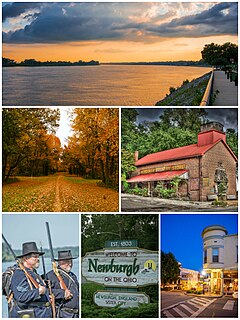
Forest Hills Historic District is a national historic district located at Indianapolis, Indiana. It encompasses 173 contributing buildings and 7 contributing structures in a planned residential section of Indianapolis. It developed between about 1911 and 1935, and includes representative examples of Tudor Revival and English Cottage style architecture.

The Richmond Downtown Historic District is an area of primarily commercial buildings and national historic district located at Richmond, Wayne County, Indiana. The district encompasses 47 contributing buildings located along the National Road. It developed between about 1868 and 1960 and includes representative examples of Italianate, Romanesque Revival, Queen Anne, Classical Revival, and Chicago School style architecture. Located in the district is the separately listed Murray Theater. Other notable buildings include the I.O.O.F. Building (1868), Hittle Building (1878), Tivoli Theater (1926), Romey's Building (1920), George H. Knollenberg Building (1877), Kresge Building, Dickinson Building (1880), former U.S. Post Office (1905), and YMCA (1908).

Linton Commercial Historic District is a national historic district located at Linton, Greene County, Indiana. It encompasses 66 contributing buildings in the central business district of Linton. It developed between about 1870 and 1950, and includes notable examples of Italianate and Romanesque Revival style architecture. Notable buildings include the Linton Masonic Hall, I.O.O.F. Building (1892), Fourth Vein Coal Company Department Story, Telephone Exchange Building (1910), Linton Post Office (1934), Cine Theater (1938), and Linton City Hall (1913).
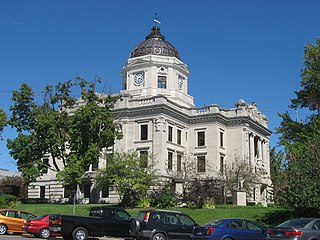
Courthouse Square Historic District is a national historic district located at Bloomington, Monroe County, Indiana. The district encompasses 57 contributing buildings in the central business district of Bloomington. It developed between about 1847 and 1936, and includes notable examples of Classical Revival, Beaux Arts and Italianate style architecture. Located in the district are the separately listed Bloomington City Hall, Monroe County Courthouse, Princess Theatre, and Wicks Building. Other notable buildings include the Federal Building, Masonic Temple, former Faulkner Hotel, Odd Fellows Building (1892), Allen Building (1907), First National Bank Building (1907), Knights of Pythias Building (1907), and Graham Hotel Building.

North Washington Street Historic District is a national historic district located in the city of Bloomington of Monroe County, Indiana. The district encompasses 35 contributing buildings and 6 contributing structures in a predominantly residential section of Bloomington. It developed between roughly 1870 and 1929, and includes notable examples of Queen Anne, Classical Revival, and Bungalow/American Craftsman style architecture. Located in the district is the separately listed Morgan House. Other notable buildings include the Showers-Graham House, Showers-Myers House, Teter House, and Washington Terrace Apartments (1929).

Prospect Hill Historic District is a national historic district located at Bloomington, Monroe County, Indiana. The district encompasses 38 contributing buildings and 8 contributing structures in a predominantly residential section of Bloomington. It developed between about 1840 and 1936, and includes notable examples of Queen Anne, Colonial Revival, Tudor Revival, Mission Revival, and Bungalow/American Craftsman style architecture. Located in the district is the separately listed Blair-Dunning House.
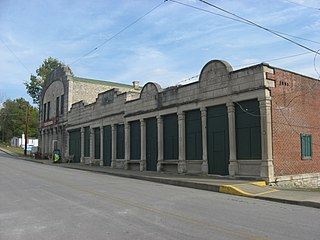
Stinesville Commercial Historic District is a national historic district located at Stinesville, Monroe County, Indiana. The district consists of five adjoining limestone commercial buildings in the central business district of Stinesville. The buildings were built between 1886 and 1894, and display elements of Renaissance Revival and Romanesque Revival style architecture. The main building is the two-story, Oolitic Lodge No. 682, I.O.O.F. built in 1894.
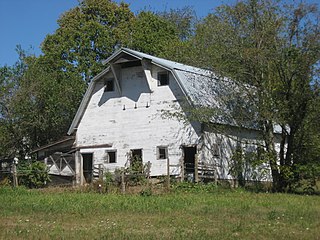
Maple Grove Road Rural Historic District is a national historic district located in Bloomington Township and Richland Township, Monroe County, Indiana. The district encompasses 69 contributing buildings, 7 contributing sites, 8 contributing structures, and 30 contributing objects in a rural area near Bloomington. The district developed between about 1828 and 1950, and include notable examples of Gothic Revival and Greek Revival style architecture. The contributing elements are located on 12 farmsteads. Located in the district is the separately listed Daniel Stout House.
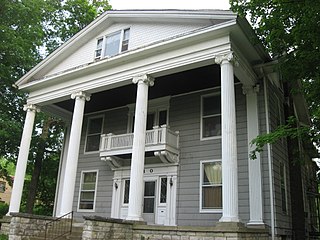
Eastern Enlargement Historic District is a national historic district located at Greencastle, Putnam County, Indiana. The district encompasses 272 contributing buildings in a predominantly residential section of Greencastle. The district developed between about 1840 and 1961 and includes notable examples of Greek Revival, Gothic Revival, Italianate, Queen Anne, Stick Style, and Bungalow / American Craftsman style architecture. Located in the district are the separately listed Delta Kappa Epsilon Fraternity, F.P. Nelson House and William C. Van Arsdel House. Other notable buildings include the Braman House (1840), James B. Nelson House, O'Hair House, John Ireland House, and a number of fraternity and sorority houses associated with DePauw University.

Farmland Downtown Historic District is a national historic district located at Farmland, Randolph County, Indiana.

Chauncey–Stadium Avenues Historic District, also known as the West Lafayette Historic District, is a national historic district located at West Lafayette, Tippecanoe County, Indiana. The district encompasses 644 contributing buildings in a predominantly residential section of Lafayette. It developed between about 1890 and 1952 and includes representative examples of Queen Anne, Shingle style, Colonial Revival, Tudor Revival, and Bungalow / American Craftsman style architecture.

Hills and Dales Historic District is a national historic district located at West Lafayette, Tippecanoe County, Indiana. The district encompasses 136 contributing buildings and 1 contributing site in a predominantly residential section of Lafayette, platted in 1922-1924. It developed between about 1911 and 1951 and includes representative examples of Colonial Revival, Tudor Revival, French Renaissance, and Ranch style architecture. Notable contributing buildings include the Haniford House, Herbert Graves House,, and Marion J. Eaton House.

Dayton Historic District is a national historic district located at Battle Ground, Tippecanoe County, Indiana. The district encompasses 82 contributing buildings and 1 contributing site in the central business district and surrounding residential sections of Dayton. It developed between about 1830 and 1952 and includes representative examples of Greek Revival, Italianate, Second Empire, and Bungalow / American Craftsman style architecture. Notable contributing resources include the Lantz Building (1941), Reincke-Hawkins House, Castle Block (1894), Baker-Yost House, First Presbyterian Church (1899), and Gladden-Goldsbury House.

Liberty Courthouse Square Historic District is a national historic district located at Liberty, Union County, Indiana. The district encompasses 20 contributing buildings and 2 contributing objects in the central business district of Liberty and centered on the separately listed Union County Courthouse. It developed between about 1854 and 1938 and includes representative examples of Italianate, Romanesque Revival, Neoclassical, and Art Deco style architecture. Notable contributing buildings include the O'Toole Building (1936), Masonic Hall, Odd Fellows Building, Liberty Opera House, and Liberty Post Office (1937-1938).

Roberts-Morton House, also known as the Old Stone House, is a historic home located in Ohio Township, Warrick County, Indiana. Just East of the town of Newburgh. It was built in 1833-1834, and is a two-story, rectangular, Federal style cut stone dwelling. It has a low gable roof and exterior end chimneys. The front facade features a two-story, Greek Revival style projecting portico.
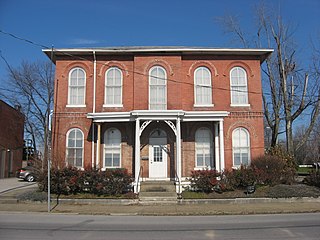
Old Warrick County Jail is a historic jail located in Boonville, Indiana. It was built in 1877, and is a two-story, Italianate style red brick building. It consists of the hipped roof former sheriff's residence at the front with the 1 1/2-story jail at the rear.

Boonville Public Square Historic District is a national historic district located at Boonville, Warrick County, Indiana. It encompasses 50 contributing buildings in the central business district of Boonville. It developed between about 1855 and 1934, and includes representative examples of Italianate, Beaux-Arts, Queen Anne, Tudor Revival, and Art Deco style architecture. Located in the district is the separately listed Old Warrick County Jail. Other notable buildings include the Warrick County Courthouse (1904), Boonville Standard (Mellen) Building (1902), I.O.O.F. Building (1896), Peoples' Bank (1939), Carnegie Library (1918), Trimble Block (1903), and Farmers & Merchants Bank (1902).

North Meridian Street Historic District is a national historic district located at Indianapolis, Indiana. It encompasses 169 contributing buildings in a high style residential section of Indianapolis. The district developed between about 1900 and 1936, and includes representative examples of Tudor Revival, Colonial Revival, and Classical Revival style architecture. Located in the district is the separately listed William N. Thompson House. Other notable contributing resources include the Evan-Blankenbaker House (1901), Sears-Townsend House (1930), MacGill-Wemmer House, Hugh Love House (1930), Hare-Tarkington House (1911), Shea House (1922), and Brant-Weinhardt House (1932).

Shortridge–Meridian Street Apartments Historic District is a national historic district located at Indianapolis, Indiana. The district encompasses 136 contributing buildings in a predominantly residential section of Indianapolis. It was developed between about 1900 and 1951, and includes representative examples of Colonial Revival, Classical Revival, Late Gothic Revival, Mission Revival, Renaissance Revival, Bungalow / American Craftsman, and Art Deco style architecture. Located in the district is the separately listed Shortridge High School. Other notable buildings include the Vernon Court Apartments (1928), Fronenac Apartments (1951), Biltmore Apartments (1927), Meridian Apartments (1929), New Yorker Apartments (1917), Howland Manor (1929), Powell-Evans House (1911), Harms House (1906), Dorchester Apartments (1921), and Martin Manor Apartments (1916).

Watson Park Historic District, also known as Watson Road Historic District and Watson McCord Neighborhood, is a national historic district located at Indianapolis, Indiana. The district encompasses 402 contributing buildings and 4 contributing sites in a predominantly residential section of Indianapolis. They include 255 houses, 27 multiple family dwellings, and 120 garages. It was developed between about 1910 and 1960, and includes representative examples of Colonial Revival, Tudor Revival, and Bungalow / American Craftsman style architecture. Located in the district is the Watson Park Bird Sanctuary.
